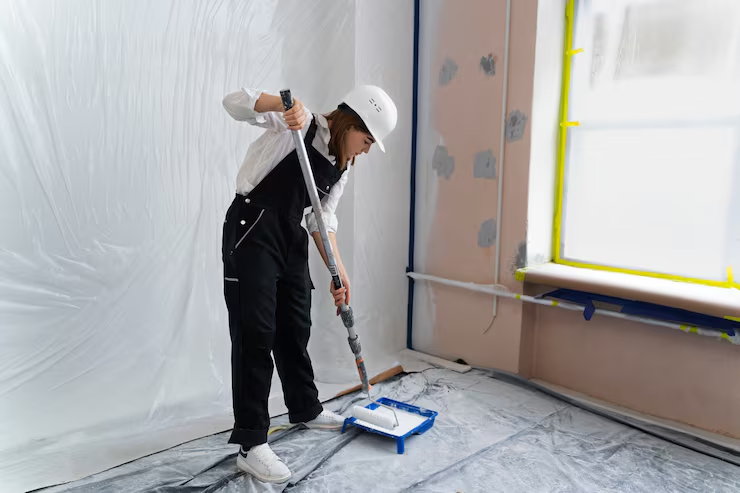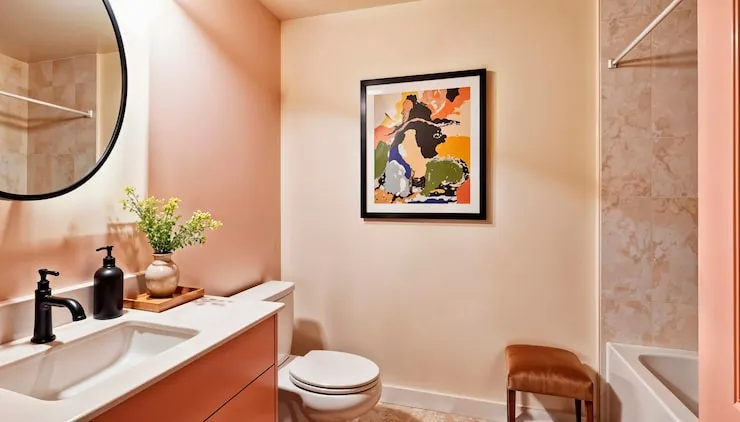Bathrooms may be one of the smallest spaces in your home, but they are also among the toughest to paint.
The constant humidity, steam, and cleaning make choosing the best paint finish for bathroom walls more critical than almost any other room.
This guide breaks down everything you need to know about finishes, from why bathrooms are different to which products actually hold up. By the end, you will know exactly what paint finish for bathroom walls, ceilings, and trim works best.
Why Bathroom Paint Is Different from Other Rooms
A bathroom is not like a bedroom or living room where moisture is limited. The shower produces steam every day, sinks splash water, and even regular cleaning involves moisture. That means the paint finish for bathroom spaces must resist all of this.
Flat or matte paints soak up water and quickly develop stains or peeling issues. In a living room, they may hide imperfections, but in a bathroom, they will not last. Instead, you need finishes that repel water, handle scrubbing, and stay strong even in humid conditions.
Understanding Paint Finishes
To understand the best paint finish for bathroom, it helps to know the common options:
- Flat/Matte: Low shine, hides wall flaws, poor moisture resistance.
- Eggshell: Slight sheen, better than flat, still weak against steam.
- Satin: Smooth, subtle shine, durable, and moisture resistant.
- Semi-Gloss: Noticeably shiny, excellent against moisture and easy to clean.
- High-Gloss: Very reflective, extremely durable, great for trim or cabinets.
When thinking about what finish paint for bathroom walls is best, you can usually rule out flat and eggshell unless they are part of a special moisture-resistant formula.
The Best Paint Finishes for Bathrooms
Now let’s focus on which finishes actually work when you want the best paint finish for bathroom surfaces.
- Satin Finish
- A favorite for many homeowners.
- It offers a mild sheen that resists moisture.
- Easy to wipe down without showing streaks.
- Works well for larger wall areas in a bathroom.
- Semi-Gloss Finish
- Highly recommended when people ask, “what finish for bathroom paint is most durable?”
- Resists water, soap, and cleaning products.
- Ideal for trim, doors, and even walls in very humid bathrooms.
- High-Gloss Finish
- The most durable finish.
- Perfect for cabinets, vanity bases, or other surfaces that face daily wear.
- Too reflective for big wall areas but excellent for accents.

These three choices—satin, semi-gloss, and high-gloss—are usually the best paint finish for bathroom projects, each depending on placement and moisture levels.
Factors That Influence the Best Finish Choice
Choosing the paint finish for bathroom walls is not a one-size-fits-all decision. A few factors influence what works best:
- Ventilation: Bathrooms with no windows or poor ventilation need more durable finishes like semi-gloss.
- Room Size: Glossy finishes can make small bathrooms feel brighter, but too much shine may highlight flaws.
- Lighting: Natural light can soften glossy finishes, while artificial light makes them appear shinier.
- Traffic Level: Guest bathrooms may do fine with satin, while family bathrooms with daily use need semi-gloss.
Keeping these points in mind helps you decide what paint finish for bathroom spaces in your home works best.
Mold-Resistant and Specialty Paints
In addition to finish, some paints are specially formulated to resist mold and mildew. These are excellent choices for humid spaces and add another layer of protection. They are often combined with satin or semi-gloss finishes to deliver both beauty and performance.
Homeowners in Missouri, where humidity can be high, benefit greatly from this extra protection. Pairing the best paint finish for bathroom with mold-resistant additives creates walls that look great and last.
Tips for Painting Bathroom Walls and Ceilings
Picking the right finish is only part of the story. For long-lasting results, follow these tips:
- Always prime bathroom walls before painting.
- Use high-quality brushes and rollers for smoother application.
- Ventilate the space during and after painting for proper drying.
- For ceilings, use matte or flat only if it is part of a moisture-resistant product.
Even the best paint finish for bathroom will fail without proper preparation and technique.
Mistakes Homeowners Make with Bathroom Paint
Many people wonder what finish paint for bathroom areas should be used but still make errors in execution. Common mistakes include:
- Using flat or eggshell finishes that cannot handle humidity.
- Skipping primer, which reduces adhesion.
- Choosing low-quality paints that peel quickly.
- Using interior paints not designed for high-humidity rooms.
Avoiding these mistakes ensures that your choice of the best paint finish for bathroom actually pays off.
Color Considerations Along with Finish
Color is exciting, but it should be chosen alongside finish.
- Light colors with satin finishes make small bathrooms look brighter.
- Dark shades with semi-gloss can be bold but need flawless prep work.
- Trim, doors, and cabinets benefit from high-gloss finishes that add contrast.
While deciding what finish for bathroom paint to use, remember that color and finish together create the final effect.
Professional Insight: Why Finishes Matter More Than You Think
Many homeowners underestimate the role of finishes. A professional knows how each option reacts to moisture, cleaning, and lighting. Proper application also ensures smooth coverage without streaks.
If you are still wondering what paint finish for bathroom spaces will last the longest, it is worth consulting experts. Companies like Better Painting help homeowners match the right products to their unique bathrooms.
How Often Should You Repaint a Bathroom?
Bathrooms tend to need repainting every three to five years because of high moisture. Signs that it’s time include peeling paint, mildew stains, and fading.
By choosing the best paint finish for bathroom from the start, you extend the repainting cycle and save money. Investing in satin or semi-gloss pays off in durability.
Conclusion
The best paint finish for bathroom walls and ceilings is usually satin or semi-gloss, with high-gloss reserved for trim and cabinets. Flat and eggshell may work in living rooms, but in a bathroom, they will not hold up.
Your choice depends on ventilation, traffic, and lighting, but durability and moisture resistance always come first.
Knowing what paint finish for bathroom projects is right means fewer repaints, easier cleaning, and a bathroom that stays beautiful no matter how much steam or scrubbing it faces.
When paired with quality products and professional application, the right finish makes all the difference.






